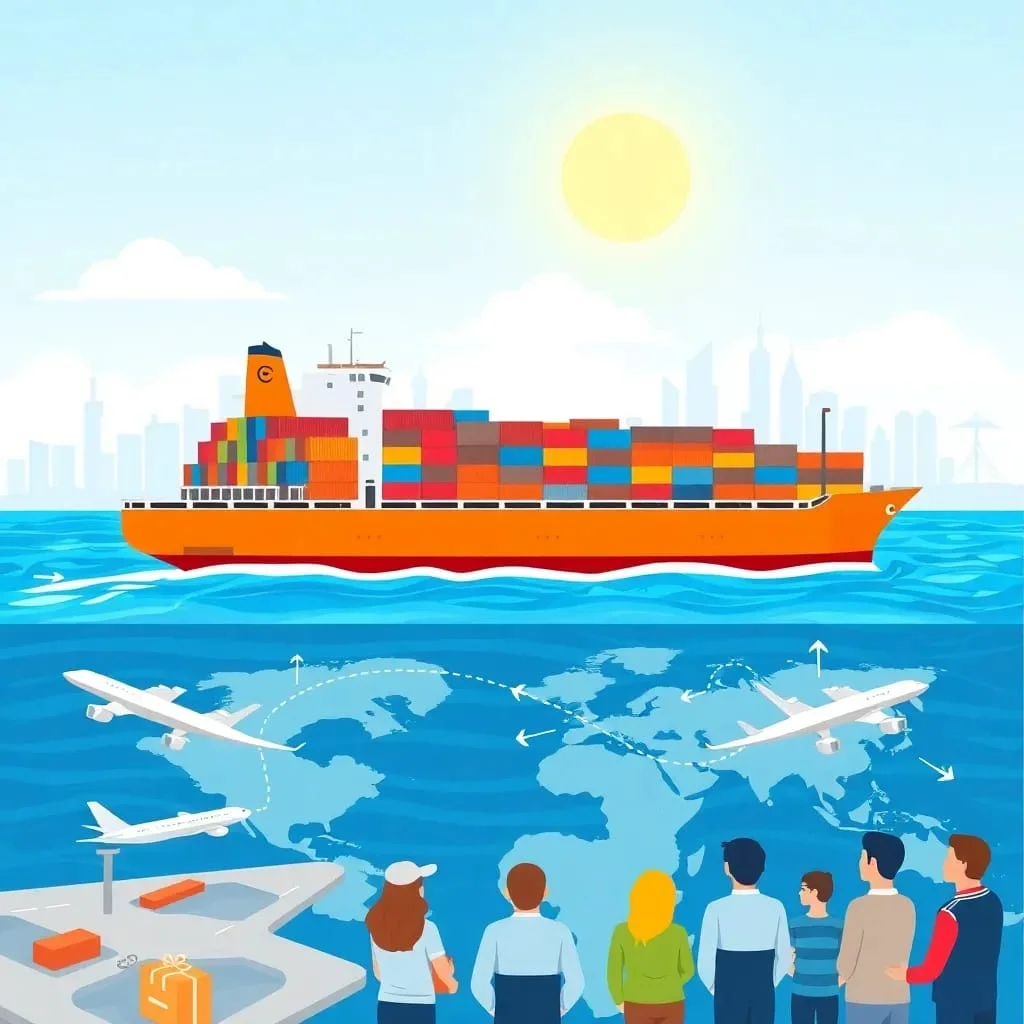International parcel shipping connects businesses and individuals across borders, enabling global commerce and personal connections. Whether you’re sending a gift to a loved one abroad or managing a global e-commerce operation, understanding the complexities of shipping internationally is crucial for success. This comprehensive guide explores everything from shipping rates and customs clearance to carrier comparisons and delivery timeframes, providing you with the knowledge needed to navigate the world of international shipments with confidence.
How does international parcel shipping work?
Understanding the international shipping process from start to finish
International parcel shipping involves a complex series of steps that transport your package from its origin to an international destination. The shipping process begins when you prepare your parcel by selecting appropriate packaging that will protect your items during transit across borders. Once packaged, you must accurately complete shipping labels with both origin and destination addresses, including proper postal codes and country names. The next critical step involves selecting a shipping service that meets your needs regarding cost, delivery speed, and tracking capabilities. Major carriers like FedEx, USPS, and others offer various international shipping services tailored to different requirements. After dropping off your parcel or scheduling a pickup, your shipment enters the carrier’s network where it goes through several sorting facilities before being loaded onto aircraft or vessels for international transport. Upon arriving in the destination country, your parcel undergoes customs clearance—a crucial phase where officials review documentation and may assess duties or taxes. After clearing customs, your shipment enters the destination country’s delivery network, eventually reaching its final destination through last-mile delivery services. Throughout this journey, tracking systems monitor your parcel’s progress, providing visibility and estimated delivery dates.
Required documentation for international shipments
Proper documentation is the backbone of successful international parcel shipping. Every international shipment requires specific paperwork to move smoothly through customs clearance processes worldwide. The most fundamental document is the customs declaration form, which provides details about the parcel’s contents, value, and purpose (whether commercial or personal). When shipping internationally through USPS, you’ll typically complete forms like the CN22 for smaller shipments or the more comprehensive CN23 for larger parcels or higher-value items. Commercial shipments require additional documentation, including commercial invoices that detail the merchandise’s description, quantity, and value. A certificate of origin may be necessary for certain destinations to verify where the products were manufactured, which can affect duty rates. Depending on the parcel contents and destination country, you might need specialized permits for restricted items, phytosanitary certificates for plant products, or FDA documentation for medical devices. Some countries require a power of attorney document authorizing the carrier to act as your customs broker. Electronic export information (EEI) filings are mandatory for U.S. shipments valued over $2,500. These documents not only satisfy legal requirements but also prevent costly delays in the shipping process. Carriers like FedEx and USPS provide guidance on documentation requirements, but ultimately the shipper bears responsibility for proper completion and accuracy.
Key players in the international shipping ecosystem
The international shipping ecosystem comprises multiple stakeholders who work together to ensure parcels move efficiently across borders. Shipping carriers form the backbone of this network, with global giants like FedEx, UPS, DHL, and USPS dominating the international parcel shipping market. These carriers maintain extensive logistics networks spanning continents, offering various shipping options from economy to premium express services. Customs authorities in both origin and destination countries play a critical regulatory role, enforcing trade laws, assessing duties, and preventing prohibited items from crossing borders. Freight forwarders often serve as intermediaries who arrange transportation, prepare documentation, and navigate customs clearance processes, particularly valuable for businesses that ship internationally regularly. Customs brokers specialize in completing customs forms and ensuring compliance with international trade regulations, helping to prevent shipment delays. Third-party logistics providers (3PLs) offer comprehensive supply chain solutions, managing everything from warehousing to international delivery. Last-mile delivery partners handle the final leg of delivery in destination countries, particularly important in regions where major carriers lack infrastructure. Digital platforms and shipping software developers create tools that streamline the shipping process, allowing for rate comparison, label printing, and shipment tracking. Insurance providers offer coverage against loss or damage during international transit. Payment processors facilitate international transactions, handling currency conversion and secure payment processing. Together, these entities form an interconnected network that enables the global movement of parcels across international boundaries.
What are the best international shipping services for different needs?
Comparing FedEx, USPS, and other major carriers
When selecting an international shipping service, understanding the strengths and limitations of major carriers is essential for making informed decisions. FedEx excels in premium international delivery services, offering exceptional reliability and comprehensive tracking for time-sensitive shipments. Their International Priority and International Economy services provide different price points while maintaining FedEx’s renowned quality. FedEx also maintains an extensive global network with strong customs clearance capabilities, though this premium service typically comes with higher shipping rates compared to other carriers. USPS, by contrast, often provides the most economical international shipping options, particularly for lightweight parcels. Their Priority Mail International and First-Class Package International Service offer reasonable delivery timeframes at competitive prices. USPS partners with postal authorities worldwide, which can be advantageous for reaching remote areas but sometimes results in less consistent tracking once parcels leave the United States. UPS provides robust service for business shipments with excellent reliability and tracking capabilities similar to FedEx. Their Worldwide Express and Worldwide Expedited services cater to different urgency levels, with particularly strong performance in business-to-business deliveries. DHL stands out for its exceptional coverage in Europe, Asia, and emerging markets where other U.S.-based carriers might have limitations. Their international parcel shipping expertise makes them ideal for businesses with global customer bases, especially in regions where they maintain stronger infrastructure than competitors. Regional carriers sometimes offer specialized international shipping services for specific corridors, potentially providing cost advantages for regular shipments between particular countries. When comparing these carriers, businesses should consider not only base shipping rates but also dimensional weight calculations, fuel surcharges, delivery timeframes, tracking capabilities, customs clearance expertise, and service reliability for their specific shipping lanes.
Priority Mail International vs. Priority Mail Express International
USPS offers two premium international shipping options that cater to different needs: Priority Mail International and Priority Mail Express International. Priority Mail International provides a balanced solution for shipping parcels abroad, typically delivering within 6-10 business days to most countries. This service includes $100 of insurance coverage (with options to purchase additional protection), tracking until the parcel leaves the United States, and delivery confirmation to select countries. The service accommodates parcels weighing up to 70 pounds and offers flat-rate boxes that can provide significant savings for heavier items, regardless of their destination. Priority Mail International represents a middle-ground option that balances reasonable shipping rates with acceptable delivery timeframes. By contrast, Priority Mail Express International serves those needing expedited shipping for urgent international shipments. This premium service delivers parcels within 3-5 business days to major global destinations, making it substantially faster than standard Priority Mail International. The service includes $200 of insurance coverage, comprehensive end-to-end tracking in most destination countries, and a date-certain delivery guarantee to select locations. While both services provide customs forms assistance and free package pickup, Priority Mail Express International commands significantly higher shipping rates—often 30-50% more than regular Priority Mail International. When deciding between these USPS international shipping services, consider both the urgency of delivery and your budget constraints. For time-sensitive documents or merchandise, Priority Mail Express International offers peace of mind with faster transit times and superior tracking. For less urgent shipments, Priority Mail International delivers considerable savings while still providing reliable service within a reasonable timeframe.
Specialized shipping options for different parcel types
International parcel shipping becomes more complex when dealing with specialized items that require particular handling or documentation. For high-value merchandise such as jewelry, electronics, or collectibles, carriers offer enhanced security options with additional insurance coverage, signature confirmation, and often more robust tracking throughout the international shipping process. These premium shipping services typically involve higher shipping rates but provide peace of mind for valuable shipments. Fragile items benefit from specialized packaging services where carriers like FedEx and UPS can provide custom crating solutions, though shippers should understand that international transit involves multiple handling points where damage risks increase regardless of carrier. Hazardous materials require specialized shipping options that comply with international regulations like the International Air Transport Association’s Dangerous Goods Regulations. Each carrier has specific protocols for handling such shipments, with mandatory documentation and packaging requirements that must be strictly followed. Oversized parcels that exceed standard dimensional limits need freight shipping services rather than regular parcel options. International freight shipping involves different pricing structures based on volumetric weight or actual weight, whichever is greater. Temperature-sensitive items such as pharmaceuticals, certain foods, or biological samples require climate-controlled shipping solutions with specialized containers that maintain specific temperature ranges throughout international transit. Live animals and plants face strict regulations that vary significantly by destination country, requiring specialized carriers with experience navigating the complex customs requirements for such shipments. For e-commerce businesses that ship internationally in volume, consolidation services can combine multiple parcels into a single shipment that crosses borders together before being separated for last-mile delivery, potentially reducing overall shipping rates. Regardless of the specialized shipping need, successful international delivery depends on selecting carriers with demonstrated expertise in handling your specific parcel type and understanding the unique customs requirements that apply to these specialized categories.
How much does international parcel shipping cost?
Factors affecting international shipping rates
International shipping rates are influenced by numerous variables that interact to determine the final cost of sending a parcel abroad. Package weight remains a primary factor, with heavier items naturally incurring higher shipping rates, though the relationship isn’t always linear as carriers implement weight brackets or tiers. Dimensional weight (calculated by multiplying length, width, and height, then dividing by a dimensional factor) often becomes the billing weight when shipping bulky but lightweight items internationally. Distance significantly impacts cost, with shipping rates typically increasing based on the geographic zones or regions defined by carriers—shipping a parcel to neighboring countries generally costs less than sending it to distant continents. The chosen shipping service level dramatically affects pricing, with express international delivery options like Priority Mail Express International costing substantially more than standard or economy services. Fuel surcharges fluctuate based on global energy prices and can add a variable percentage to base shipping rates. Destination country influences costs through various mechanisms, including different delivery infrastructure requirements and carrier partnerships that affect operational expenses. Customs duties, taxes, and fees vary widely by country and are typically based on the declared value of the shipment, becoming part of the total international shipping cost. Insurance coverage, whether included in basic service or purchased additionally, increases proportionally with the parcel’s declared value. Special handling requirements for fragile, oversized, or regulated items incur supplemental charges. Delivery area surcharges apply to remote or difficult-to-access locations within destination countries. Volume discounts can significantly reduce shipping rates for businesses that ship internationally in quantity. Seasonal factors cause rate variations during peak shipping periods like holiday seasons. Currency exchange rates affect international shipping costs when paying in different currencies. Pickup options versus drop-off can add convenience fees. Understanding these factors helps shippers anticipate costs and identify potential savings opportunities when developing an international shipping strategy.
Hidden fees and surcharges to watch for
The advertised base rates for international parcel shipping often represent only a portion of the actual cost, with various surcharges and hidden fees potentially increasing the final bill significantly. Fuel surcharges fluctuate regularly based on global oil prices and can add 5-25% to the base shipping rate, varying by carrier and rarely prominently displayed in initial price quotes. Remote area delivery surcharges apply when shipping to destinations outside major metropolitan areas, with some carriers charging substantial premiums for delivering to islands, highlands, or rural locations. Residential delivery fees are often assessed when shipping internationally to home addresses rather than businesses. Address correction charges can be surprisingly steep if the shipping label contains errors or omissions that require carrier intervention. Dimensional weight adjustments occur when a package’s dimensional weight exceeds its actual weight, potentially multiplying the expected shipping rate for bulky items. Peak season surcharges are implemented during high-volume periods like holidays, temporarily increasing international shipping rates. Import duties and taxes, while not technically carrier fees, often surprise recipients who may refuse shipments when faced with unexpected charges, potentially resulting in return shipping costs for the sender. Currency conversion fees apply when carriers process payments across different currencies. Insurance limitations can lead to unexpected costs if valuable items are lost or damaged beyond the carrier’s liability limits. Delivery signature requirements or other special handling requests incur additional fees that vary by carrier and destination country. Paper invoice fees are increasingly common as carriers push customers toward electronic billing. Customs clearance administrative fees are sometimes charged separately from the actual duties and taxes. Storage fees accumulate when shipments face customs delays and require warehousing. Weekend or holiday delivery premiums apply for expedited international shipping services delivered outside normal business days. Understanding these potential hidden costs allows shippers to request comprehensive rate quotes and accurately compare total shipping expenses across different carriers and shipping options.
Cost-saving strategies for regular international shipments
Businesses and individuals who frequently ship internationally can implement several strategies to reduce shipping rates and optimize their international delivery expenses. Negotiating contracted rates with carriers becomes viable once you maintain consistent shipping volume, with discounts typically starting at 10-15% off published rates and potentially reaching 30% or more for high-volume shippers. Consolidating shipments by combining multiple parcels destined for the same region can significantly reduce per-item shipping costs, particularly valuable for businesses with regular order volumes to specific international markets. Utilizing flat-rate shipping options like USPS Priority Mail International flat-rate boxes eliminates weight-based calculations (up to the maximum allowed weight) and provides predictable shipping rates regardless of destination country. Optimizing packaging by using appropriately sized boxes and minimizing dimensional weight through efficient packing techniques directly impacts shipping costs. Comparing multiple carriers rather than defaulting to a single shipping service ensures you leverage competitive pricing across different shipping lanes. Implementing shipping software that integrates with multiple carriers allows for automated rate shopping to select the most economical shipping option for each parcel. Timing non-urgent shipments to avoid peak seasons can help circumvent temporary rate increases and surcharges. Accurately completing customs forms prevents costly delays, returns, or additional processing fees that often exceed the original shipping costs. Using carrier-provided packaging for services that offer it (like Priority Mail International) eliminates packaging expenses and ensures compliance with carrier requirements. Exploring postal service options through USPS for lighter parcels often reveals substantially lower shipping rates than express carrier alternatives. Considering hybrid services where major carriers handle international transit while local postal services manage last-mile delivery can provide significant savings. Purchasing insurance selectively based on actual item value rather than automatically insuring all shipments helps reduce unnecessary coverage costs. Prepaying customs duties and taxes when advantageous prevents delivery delays and potentially reduces overall customs clearance costs. Establishing fulfillment centers in key international markets might become cost-effective for businesses with significant volume to specific regions, eliminating international shipping entirely for those customers.
What customs requirements should I know for international parcel shipping?
Completing customs forms correctly
Accurate customs forms completion stands as perhaps the most critical aspect of successful international parcel shipping. Every international shipment requires proper documentation that declares the contents, value, and purpose of the parcel crossing borders. The most commonly used customs forms for international shipments include the CN22 (for lower-value shipments), the more detailed CN23 (for higher-value shipments), and commercial invoices for business transactions. When completing these forms, precise item descriptions are essential—vague descriptions like “gift” or “merchandise” often trigger additional scrutiny or delays. Instead, provide specific descriptions (e.g., “men’s cotton t-shirt” rather than just “clothing”). Accurate valuation represents another crucial element, as understating item values constitutes customs fraud with potential legal consequences, while overstating values unnecessarily increases the recipient’s duty liability. The Harmonized System (HS) codes classify goods for international trade, with proper classification ensuring appropriate duty assessment—many carriers and shipping platforms provide tools to help identify correct HS codes for your items. The country of origin must be accurately declared to determine applicable trade agreements and duty rates. When shipping internationally for commercial purposes, indicating the terms of sale (Incoterms) clarifies whether the sender or recipient bears responsibility for duties and taxes. Electronic customs forms have largely replaced paper documentation for international shipping services, with carriers like FedEx, USPS, and others providing digital submission methods that reduce errors and expedite customs clearance. Multiple copies of documentation should accompany commercial shipments, with conventional practice suggesting at least three copies—one for departure customs, one for arrival customs, and one to accompany the goods. For regulated items like food, electronics, textiles, or cosmetics, additional documentation may be required to meet destination country import requirements. Proper signature and date on all customs forms legally attest to the accuracy of the declaration, making the shipper liable for any misrepresentations.
Understanding customs clearance procedures
Customs clearance represents the gateway through which all international shipments must pass before reaching their recipients. The process begins when your parcel arrives in the destination country and is presented to customs authorities by your carrier. These officials assess whether the shipment complies with local import regulations and determine applicable duties and taxes. During formal customs clearance, officials examine the customs forms and supporting documentation accompanying your parcel, verifying that the information matches the actual contents. They assess the harmonized tariff code classification of your items, which determines the duty rate applied. The customs value calculation.







